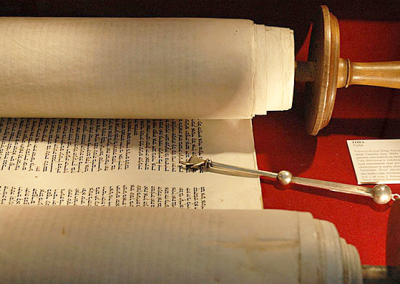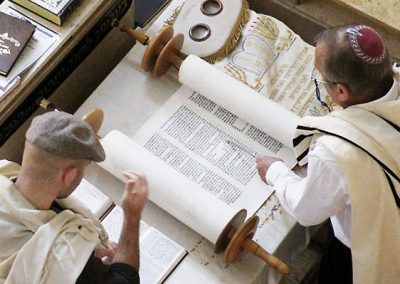
Bible, History, Archaeology
Bible,
History,
Archaeology
The Sefer Torah
Contents:
Watch the video – Introductory text – Image gallery
Video from the program «À l'origine» hosted by Steve Suissa on France 2. With the participation of rabbi Michaël Azoulay and sofer Roland Attias. © France 2.
The Sefer Torah (Hebrew: ספר תורה - «book [of] Torah» or more exactly Torah scroll (plural: Sifrei Torah) is a handwritten copy of the Torah (or Pentateuch), Judaism's holiest book. The conditions under which it is produced are extremely strict, and only by authorized scribes (Sofrim).
Introduction
Once completed, the Sefer Torah is stored in the synagogue's most sacred place, the Aron Kodesh («Holy Ark», in reference to the Ark of the Covenant), a cupboard usually adorned with embroidered hangings, in a section facing Jerusalem.
Image opposite: Procession of several sifrei Torah during a Jewish festival. Felix Lipov 248715673.
A Sefer Torah contains 304,805 letters, all of which must be precisely written by a qualified scribe («sofer»). An error in transcription can render the Sefer Torah invalid. All manuscripts must also be written on parchment with salt, flour and m'afatsim to be valid.
The calf or parchment on which the sacred Hebrew text is written is mounted in a wooden case called עץ חיים (tree of life) in Hebrew. The case features two rollers, each with two handles used to scroll the text, for a total of four handles. Between the handles and the scrolls are round plates or disks engraved with images of holy places, engraved with dedications to the donor's parents or their relatives, and decorated with gold or silver.
Most modern Sifrei Torah are written with forty-two lines of text per column (Yemenite Jews use fifty-one). Strict rules govern the position and appearance of the Hebrew alphabet. Faithfulness to the Hebrew text of the Tanakh, and the Torah in particular, is considered paramount down to the last letter: translations or transcriptions are frowned upon for liturgical use, and transcription is carried out with meticulous care.
The completion of a Sefer Torah is an occasion for great festivity, with guests invited to a celebration during which everyone has the opportunity to write one of the last letters.
A Sefer Torah (Ashkenazi) and a yad, a reading pointer for liturgical use. © Merlin.
A Sefer Torah (Ashkenazi) and a yad, a reading pointer for liturgical use.
Procession of several sifrei Torah on a Jewish holiday. Public domain.
Procession of several sifrei Torah during a Jewish festival.
The various elements involved in the manufacture of writing ink for a Torah. Public domain
The different elements involved in the manufacture of writing ink for a Torah.




